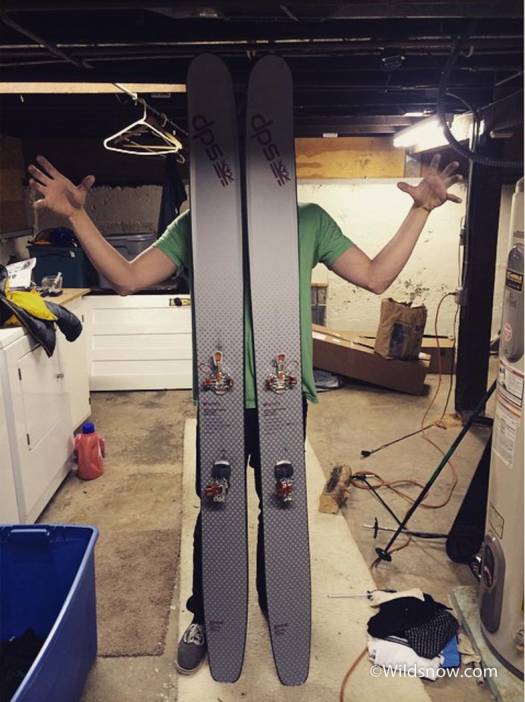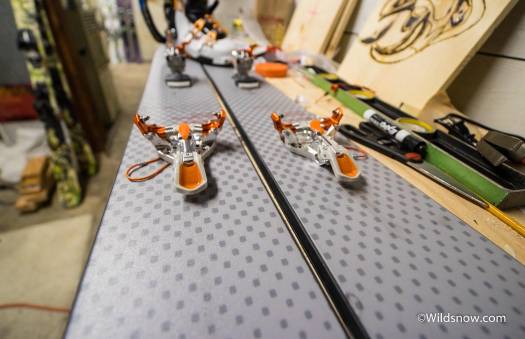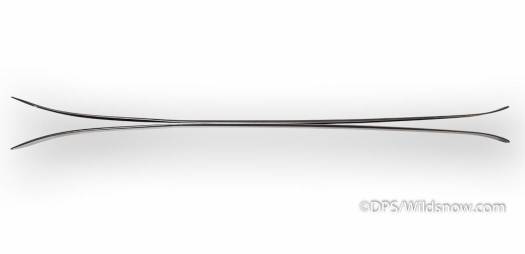DPS Spoons are becoming legendary backcountry powder skis. They had a huge media buildup in their development, and they’ve gone through quite a few iterations. They’re designed as “the ultimate deep snow ski.” The Spoons have got the eponymous spoon shape at the tip and tail, as well as a super wide, reverse-reverse shape. Even with their massive size, they utilize carbon fiber for somewhat reasonable weight. They are one of the few ultra-fat skis that are light enough to skin with if you’re in shape and get your legs used to it (catalog weight 2250 grams, 79 ounces per ski, which seems spot on).
The specs on the Spoons are impressive. They come in any length you want — as long as it’s 190cm. Dimensions are 158/148/151 — huge. The tip rocker length is 63 cm, and the tail rocker length is 44 cm. That only leaves 83 cm of the ski flat on the snow.
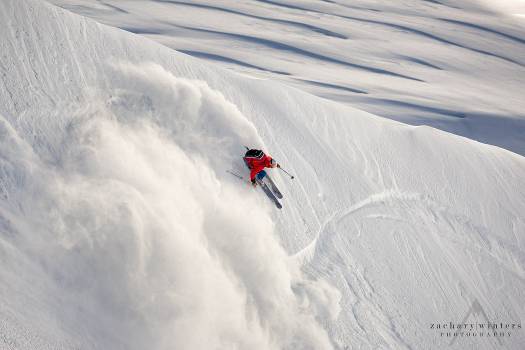
Having a great time ripping down an Alaskan face on the Spoons this last spring. These things excel in powder, especially at high speeds. Photo by Zach Winters, check out his other awesome photos here.
Although last winter (2014-2015) in the PNW left something to be desired when it came to backcountry skiing pow, I still managed to find some deep stuff. I took it upon my shoulders to find shoulder level pow for a worthy test (someone’s got to do it). I originally got the skis when I was planning on going to Japan for the first time. I ended up taking them, as well as the more versatile DPS Wailer 112. Although we didn’t quite find days upon days of epically deep pow in the Orient, we still got a bit, as well as copious amounts of silky boot-top fluff. After that, I used the Spoons a few times in Washington. I even decided to take them on our Alaska basecamp ski touring trip this spring.
In Japan, the enormous Spoons almost fit in. Most of the other skiers we saw had something similarly gigantic. Even still, they were some of the biggest sticks around. We had a great variety of conditions on our trip, everything from ice to deep pow. Good testing.
Of course the Spoons’ performance in deep pow is incredible. They’re surfier and floatier than anything else I’ve skied. The gigantic surface area and rocker make it easy to ride the skis with your weight centered, even in deep snow. It’s awesome to jump and slash through the pow on these things. Some say that super fat skis make powder skiing less fun, making you ski on top of the powder rather than in it. However, from my experience I’d have to disagree. Yes, they do make you ride on top when you are riding straight down the fall line, but every turn they really show their strengths. You have a much greater freedom in what style you turn; either traditionally, slarvy-slashy, or you can put some energy into it and push down into the snow, getting a massive face-shot. The fact that the skis almost always pop back up to the surface like a beach ball in a pool makes them incredibly easy to ski, and enables you to ski in ways you can’t on skinnier skis.
You might say: “of course they are awesome in pow, what about all those other pesky snow conditions?” You might think Spoons are about as versatile as a 65 mm rando stick. Of course these DPS monsters are incredibly powder specific, more so than most other skis. However, they handle hard snow better than one might expect. The best non-pow testing I did was on icy snow during night skiing in Niseko. Skittering around at high speed on a dark, icy resort that hadn’t seen snow in an uncharacteristically long time was a pretty good evaluation. While the Spoon certainly wasn’t ideal, they were surprisingly functional… I survived. I’d even say they were pretty fun. Of course I had to adjust my skiing style a bit; any sharp turns had to be triggered well in advance, and drifted rather than carved.
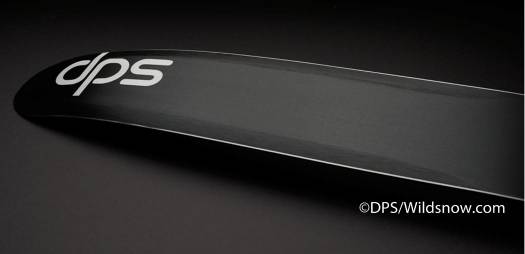
Although toned down from previous versions of the ski, the convex “spoon” shape is still obvious. Photo courtesy of DPS.
The spoon! Easily the most unique feature of the Spoons is the convex eating utensil shaping of the base at the tip and the tail. With each version of the ski, since the first prototypes were shown a few years ago, the spoon shaping has gradually diminished until the current form. The skis have only a bit of spoon in the tip and tail. The center of the ski is fairly traditional, with tiny sidecut and a flat base.
All that said, I’m not 100% convinced the spoon shaping does anything. Could it be a gimmick? The skis are of course awesome in powder, and have an incredible amount of maneuverability and slarvability. However, I wonder if the same ski only without the spoon would be noticeably different. Nothing a grinder and saw won’t take care of — where is the WildSnow test center when I really need it (just kidding)?
An interesting side note is that I saw several ski companies in Japan that utilized spoon shaping in their skis. In North America I’ve only seen a few companies besides DPS that have ventured into the realm of convex bases (i.e., Garywayne). In Japan we saw convex skis all over the place.
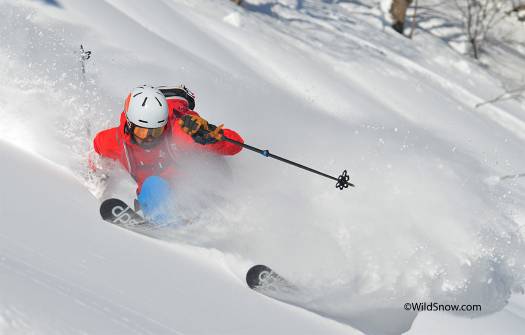
Slashing with the spoons in awesome Japanese powder. This picture shows the convex tip area of the spoons interacting with the snow. Maybe they do something?
Another question I hear is how are Spoons for skinning? They are actually fairly light for their size, but I’d still call them heavy for human powered ski touring, with large surface area. Even on a well used skin track I found that I had to expend energy breaking a little trail to make the skin track wider. As for the substantial rocker and “spoon” effect, that didn’t seem to affect the skinning grip much. I didn’t have a pair of skins that came close to fitting the Spoons, so I simply cut some down the middle to make a makeshift pair of split skins. Although I have some friends who do that to use one pair of skins over many pairs of skis, I’ve never tried it. It worked surprisingly well. The DIY splits stayed stuck to the skis most of the time, although they fell off occasionally after many laps in cold powder. The major issue I found was folding them in the wind. I’d recommend splitting as a good way to get a pair of skins for fat skis that aren’t going to be used for gigantic days. Wider skis are ideal since even with the split skins, there is still plenty of grip area.
The Spoons are awesome skis, and live up to the considerable hype. They are a sports car; not ideal for everyday conditions, but they sure are fun to drive! For a powder specific backcountry ski, especially one that will be used for occasional skinning, they are hard to beat.
If you feel like taking the plunge and getting a pair, and supporting our site partners, you can shop them from Cripple Creek here.
Louie Dawson earned his Bachelor Degree in Industrial Design from Western Washington University in 2014. When he’s not skiing Mount Baker or somewhere equally as snowy, he’s thinking about new products to make ski mountaineering more fun and safe.

